Remembering BorgWarner...Ten Years Later
This year marks the tenth anniversary of the final shutdown and closing of the BorgWarner factory here in Muncie. The company manufactured automotive parts, specifically manual/automatic transmissions and transfer cases. Some examples of BorgWarner automotive products include the T-90, T-84, T-85, T-87, T-5, and T-50 manual transmissions. For automatic transmissions, the company built the M35, M44, M8, M11, and M12. BorgWarner also built transfer cases for Ford trucks (e.g. BW 4411, BW 4406, 1354, 4405).
BorgWarner, or Warner Gear as it was previously known, had over 100 years of history within the Muncie community providing manufacturing jobs to those who lived in East Central Indiana. Like many other early manufacturers, the company’s founders came to Muncie, IN because of the proliferation of natural gas found in the area during what is now termed the Gas Boom era of Muncie’s history. After the gas began to run dry, opportunity came in the form of automobile manufacturing, specifically automobile parts (Automobility, n.d.). From there, the factory grew so much so that it had to move locations or expand facilities a number of times reaching peak employment in the 1950s in the post-World War II boom.
| This map shows the different locations of BorgWarner within Muncie. Built using Google Maps |
It also underwent a few name changes. In early years, it was known as Warner Gear, Warner being the family name of the people who started the company at the beginning of the 20th century and gear referencing the transmissions that the company built (Automibility, n.d.). In 1928, Warner Gear, Borg & Beck, and Marvel Carburetor merged into BorgWarner, but the Muncie plant was still called Warner Gear. By 1985, the plant was called BorgWarner Automotive after its parent company until it closed in July 2009.
Timeline of BorgWarner's History in Muncie
| BorgWarner’s history in Muncie from 1901-2017 using Timeline JS. Information and photos sourced from the Star Press, Ball State Archives, and the BorgWarner newsletters and compiled by Sara McKinley and added to by Alexis Robertson. |
Despite the closing of the plant in 2009, BorgWarner still remains close to people’s hearts, especially those who once worked at the plant. It was a huge support to the employees as well as the community as a whole, and the people here in Muncie still lament that loss along with the other major factories that used to be the backbone of industry like the Chevrolet plant and Ball Bros. Corporation. Last year, this was evidenced by reactions and the discussion after watching Changing Gears, a documentary about the closing of BorgWarner, which was shown at Muncie Public Library at the first Warner Gear (BorgWarner) Reunion event held in May 2018.
|
Changing Gears documents the closing of BorgWarner and examines why the factory closed after over 100 years within the community. Video courtesy of and used with the permission of Ball State University Archives and Special Collections. Ball State University Libraries. (2016). Changing Gears: End of an Era, 2010 [Video file]. Retrieved from https://www.youtube.com/watch?v=IjNn7Znl-s4 |
Work Life | BorgWarner Community | Closing of BorgWarner | Muncie's Future | Resources
Work Life
What did a day in the life of a BorgWarner factory worker look like? Although the company had many different departments for the variety of jobs needed, most people who worked in the plant came to work, clocked in and out for the day, had lunch and breaks, and performed their specific jobs whether that was assembly, quality control, heat treat, gray iron, labor, R2, F9, or E3. The workers were paid well, had great benefits, and the company really tried to create a community within the plant. Some jobs were harsher than others depending on the task and the working environment, but overall, the work provided a good standard of living for those employed at BorgWarner.
Listen to the daily experiences of these workers. Was your experience similar to theirs? How was it the same? How did it differ?
|
Frank Scott, Marlene Mitchell, and John Fenimore talk about their experience working for Warner Gear or BorgWarner as it was known in later years in Muncie. BorgWarner Oral History Collection (2019), Muncie Public Library, Muncie, IN. |
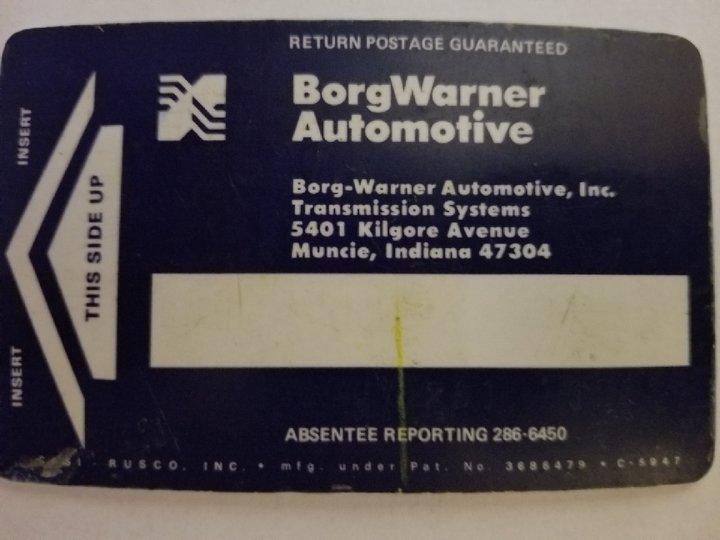 |
|
BorgWarner employees used this card to clock in and out for their work day. BorgWarner plant punch card, circa 1986-2009 |
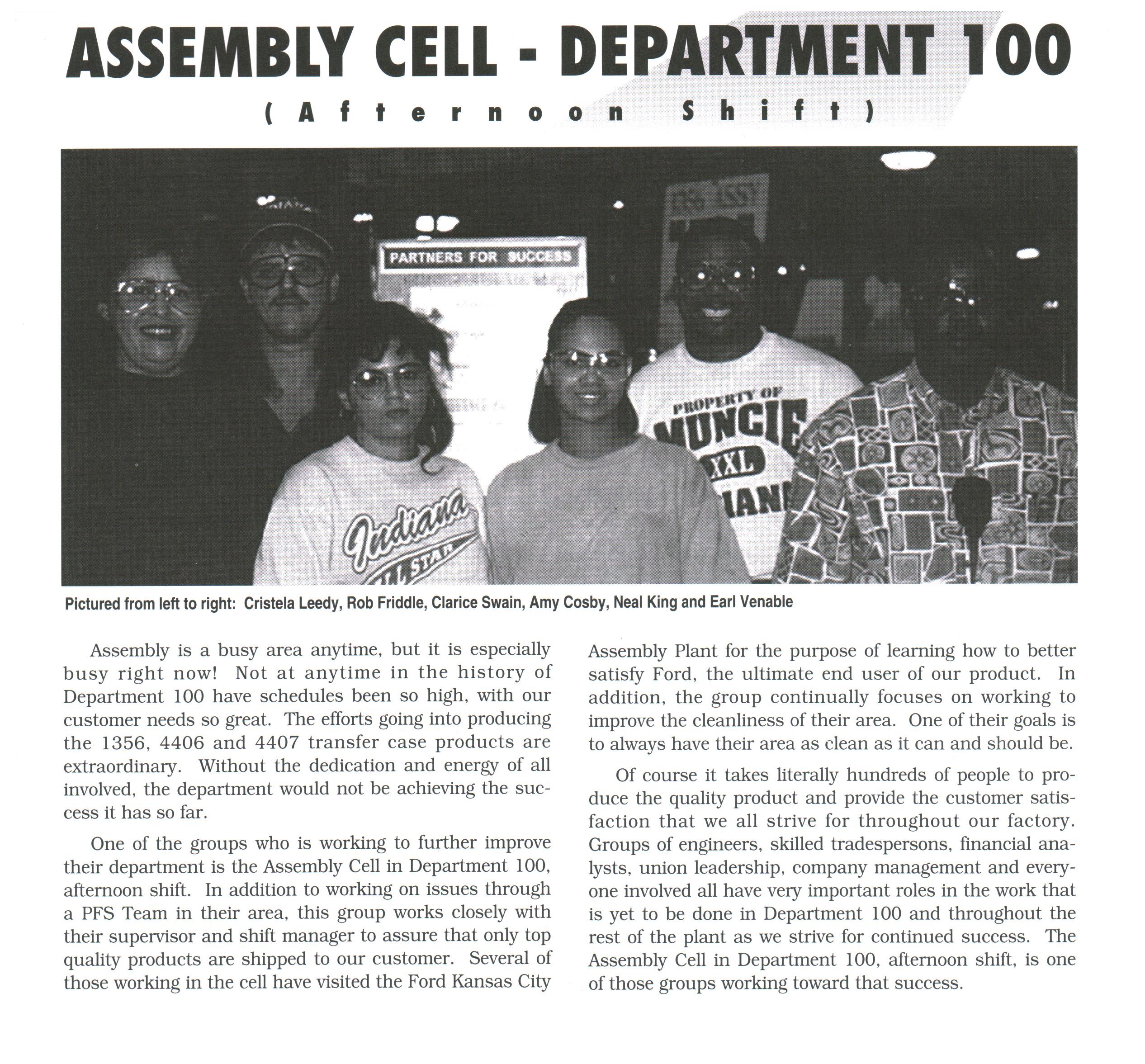 |
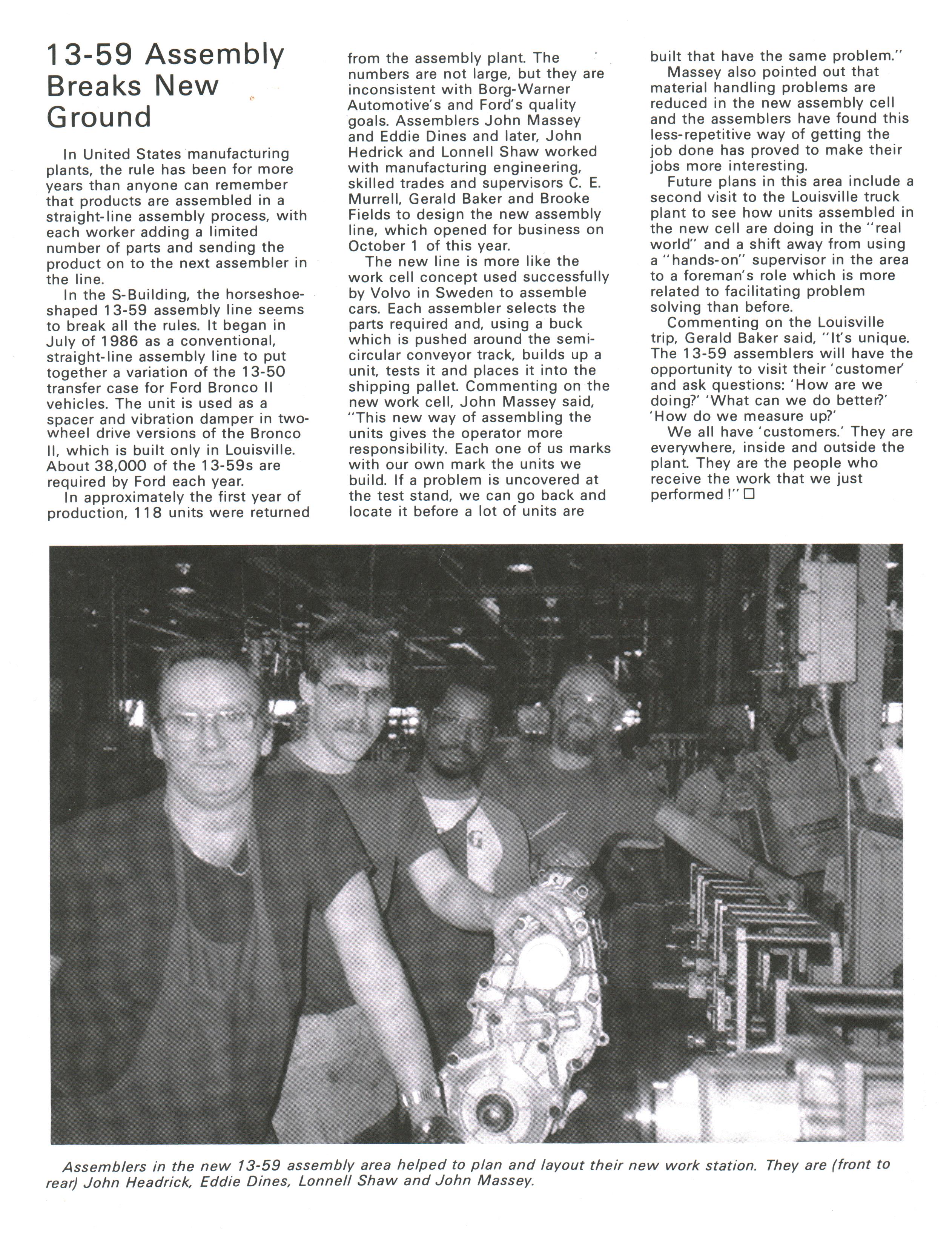 |
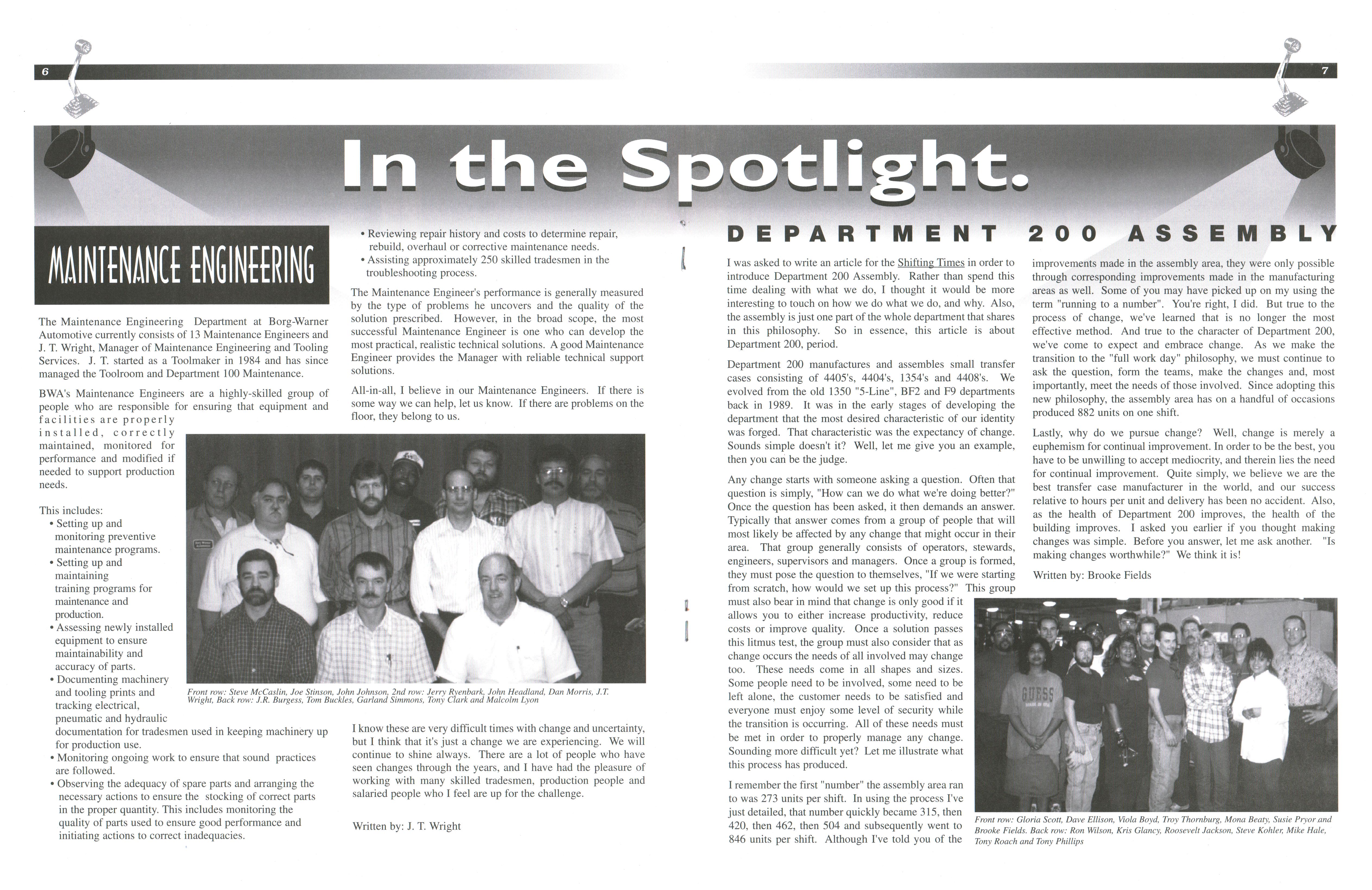 |
|
Recognize any faces? Occasionally, the plant would spotlight different areas in order to let employees know more about those departments and any exciting news happening within them. These snippets were taken from the November 1987 edition of The News (p.2) and the September 1995 (p.5) and January 1997 (p. 6,7) editions of Shifting Times, the BorgWarner employee newsletter. BorgWarner Newsletter Collection (1944-2004), Muncie Public Library, Muncie, IN. |
||
Quality and BorgWarner
In the 1980s, BorgWarner defined itself as a company that valued and trusted its people, one that was open and honest within the work environment. Good customer service was also high on the priority list for BorgWarner, and on top of that, the company stressed good quality and trustworthy investment into innovation and forward thinking regarding the technology produced at the plants. Many of the people who have spoken about the company have also said this about BorgWarner and took great pride in the product that they created. They tried to ensure that BorgWarner products were of the best quality.
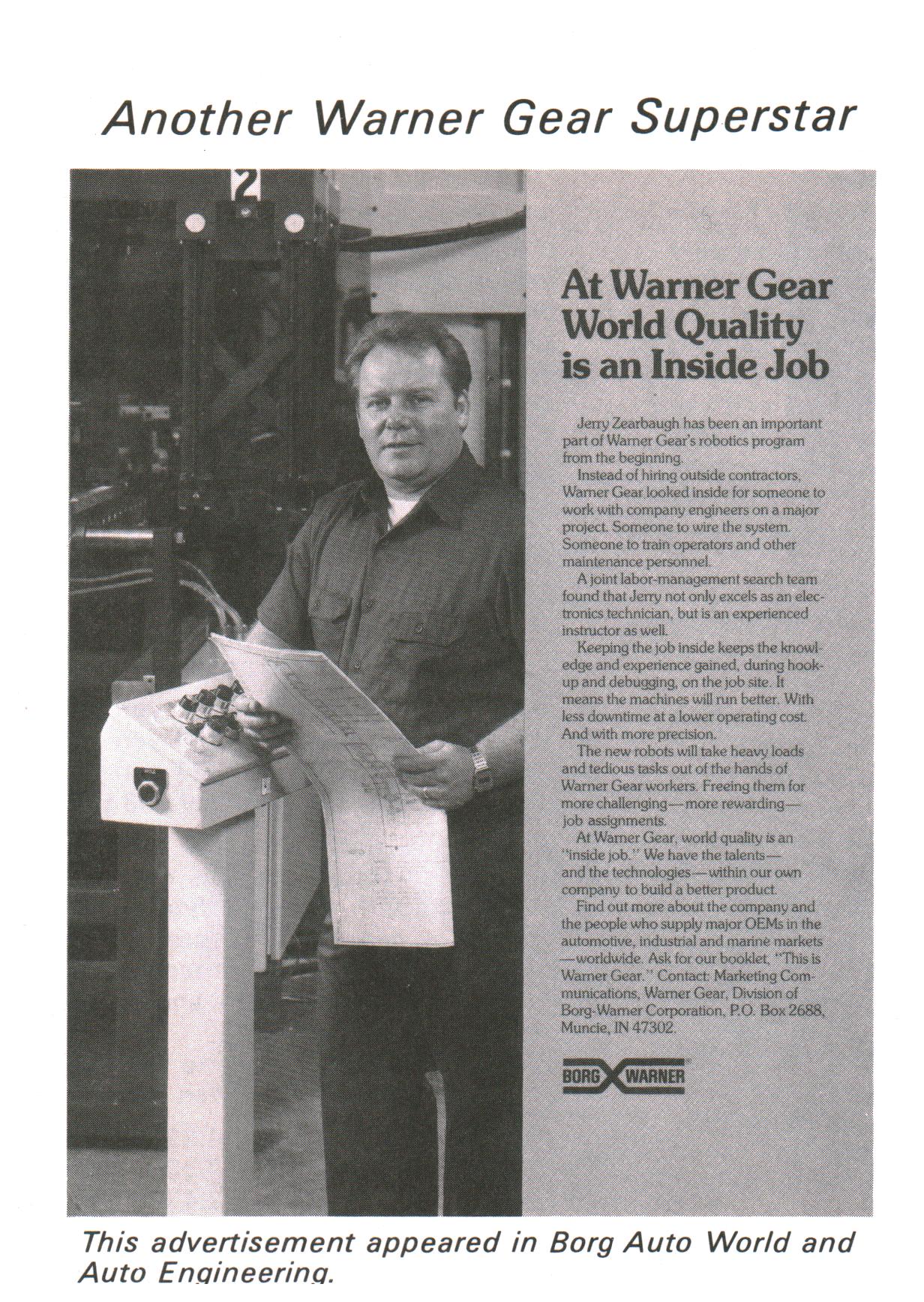 |
|
This is an ad that appeared in the April 1984 edition of Warner Gear News (p.4). BorgWarner Newsletter Collection (1944-2004), Muncie Public Library, Muncie, IN. |
Tim Manganello (May 1998) in one of his letters to employees quoted a slogan used by the company in 1913 when it was called Warner Gear to stress one of its continuing core values. “Quality is remembered long after price is forgotten”, which also happens to be a quote contributed to Henry Royce of Rolls Royce fame. How did BorgWarner ensure that the product met quality standards? Through Statistical Process Control…
During his BorgWarner career, Frank Scott worked within Statistical Process Control (SPC) for twenty years, and he analyzed “process capability to see how good the machines are….” One of the tools of the trade is this quincunx.
Using the quincunx, the company could simulate real processes in order to gauge how well the machine runs to build the parts. This tool allows quality control to pinpoint needed machine adjustments using greater statistical numbers as opposed to resetting the machine based on smaller numbers, which leads to more variation of parts and thus lesser quality.
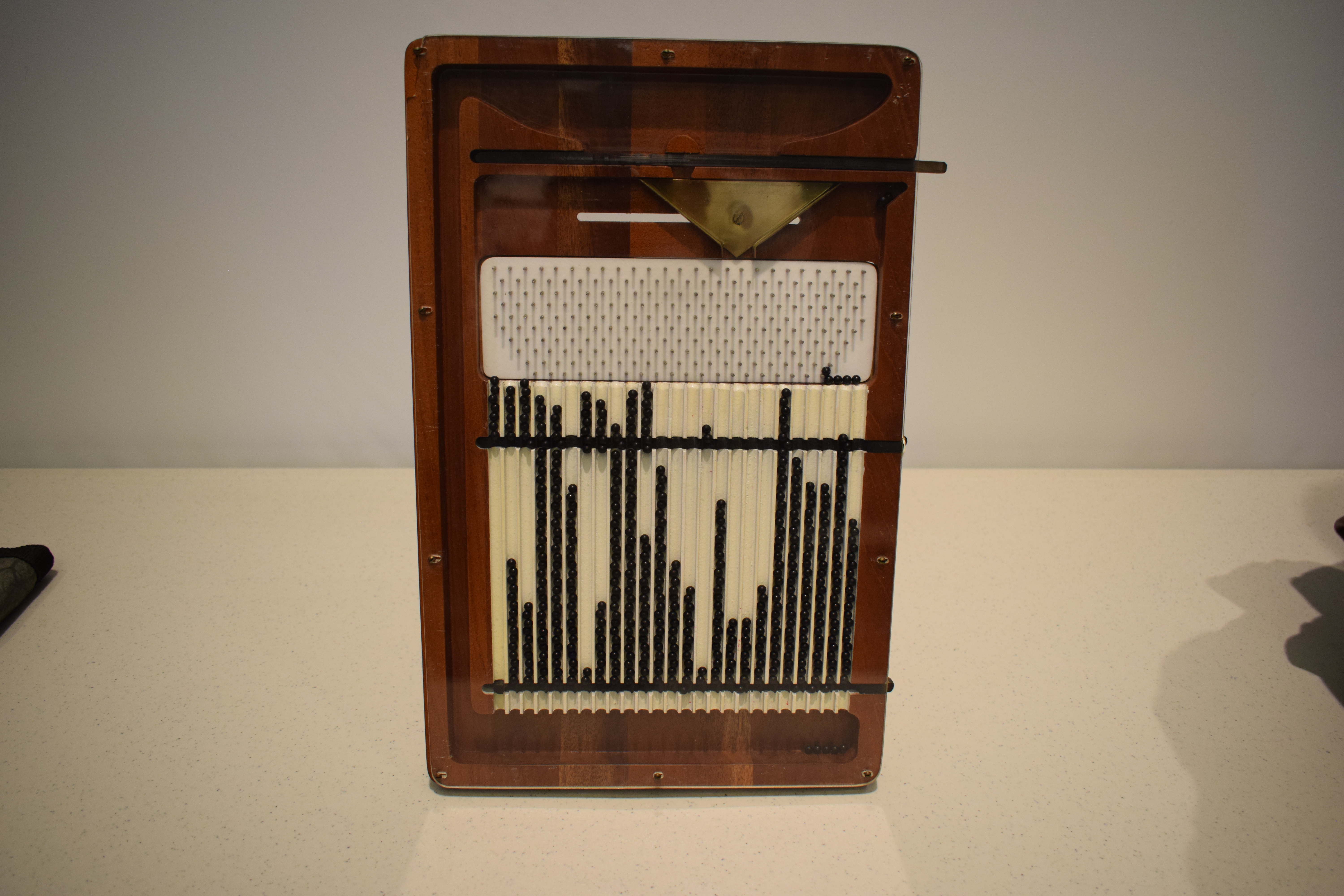 |
|
|
Quincunx, ca. 1989, owner: Frank Scott Invented by Francis Galton in the 1890s, the quincunx is a tool used to show how frequency distributions are created in quality control training. At the top of the board is a chamber filled with beads which are then fed into a triangular hopper by way of a horizontal sliding bar. The beads then tumble through the rows of pins which direct them either left or right . The beads then fall into the vertical slots in the lower half of the board in order to create a frequency distribution. (Quincunx board, 2019) |
|
Another tool that Frank used in the SPC department was the red bead machine. This tool could help predict the quality of parts based on knowable and hopefully controllable factors. In theory, if someone runs a machine exactly as he or she should, all of the parts should be constructed in the way that they should be. However, other factors will affect the part such as temperature and the quality of the materials used to make the part. Beads representing those factors are placed in the red bead machine to predict how many parts will come out as defective and the reason why based on the color of the bead.
|
|
|
|
Red Bead Machine, ca. 1989, owner: Frank Scott The Red Bead Experiment was developed by Dr. W. Edwards Deming in order to understand variation in processes. The sampling bowl seen here contains 80% white beads and 20% red or other colored beads. The other colors represent the defective items or anything that can go wrong in the process (McNeese, 2009). BorgWarner used Statistical Process Control as part of its quality control. |
|
Watch as Frank Scott demonstrates how to use the quincunx and the red bead machine.
|
Frank Scott explains how to use the quincunx and red bead machine. In his job within Statistical Process Control, Frank and his co-workers used these ideas to streamline production processes and to better the quality of the product. BorgWarner Oral History Collection (2019), Muncie Public Library, Muncie, IN. Videographer: Dan Allen |
Although quality control was Frank’s job for twenty years at BorgWarner, all departments in their own way ensured that quality was synonymous with BorgWarner by taking great pride in the craftsmanship of the product or ensuring that the workplace stayed clean and the machines performed properly. In what other ways did BorgWarner ensure the quality of their product? Why was this so important within the company’s culture? Tell us your story!
Investigate the Archives: To learn more about Statistical Process Control, check out the BorgWarner Newsletter Collection located in the archives at the Carnegie branch of Muncie Public Library. |
Healthcare, an example of benefits
Many people that have talked about their time at BorgWarner said that the company was a great place to work in terms of the pay and the benefits. One such benefit was healthcare, and as we will see later on, this particular perk eventually led to the closing of the plant here in Muncie due to the rising healthcare costs in the United States. This was already a discussion happening in the 1980s within the plant.
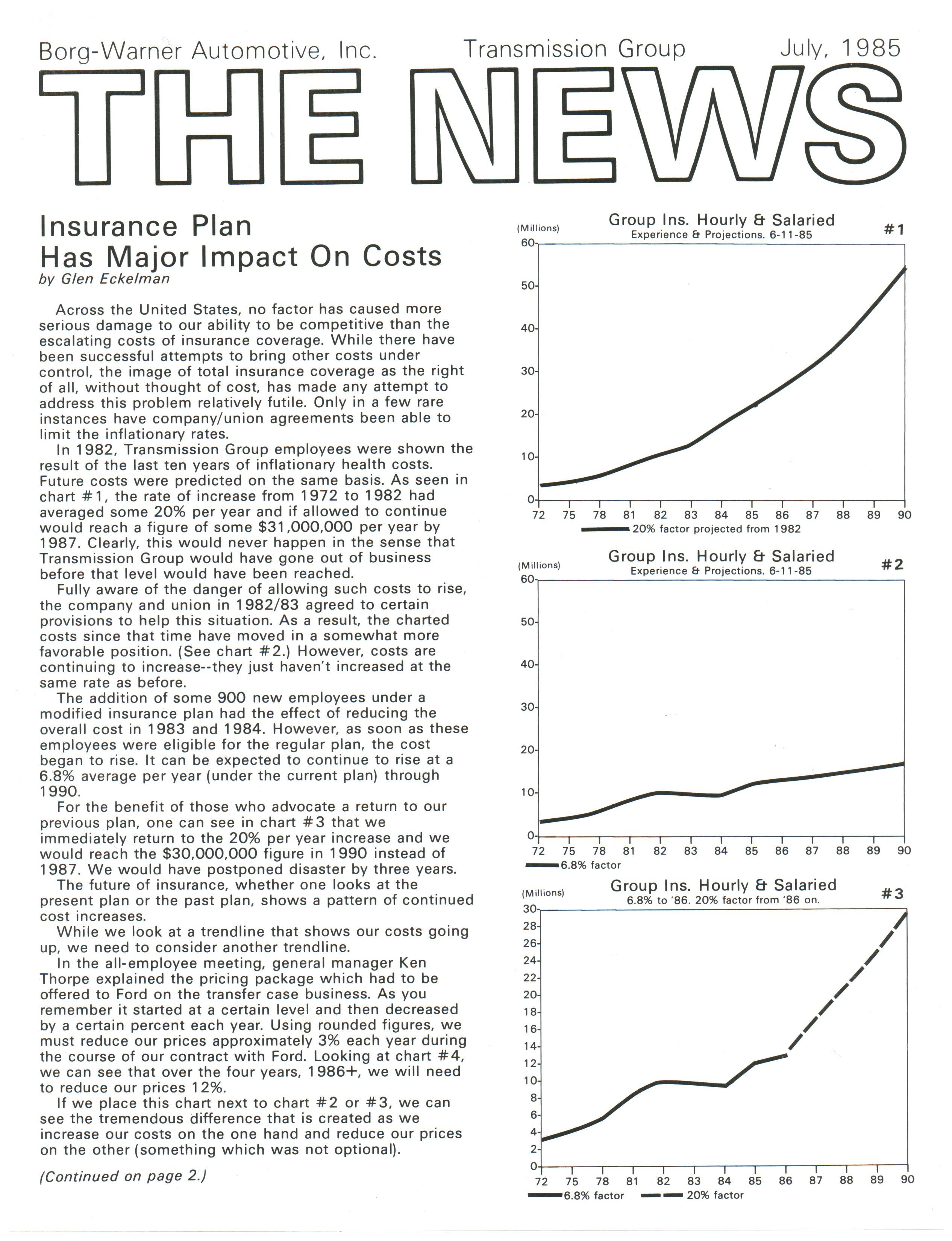 |
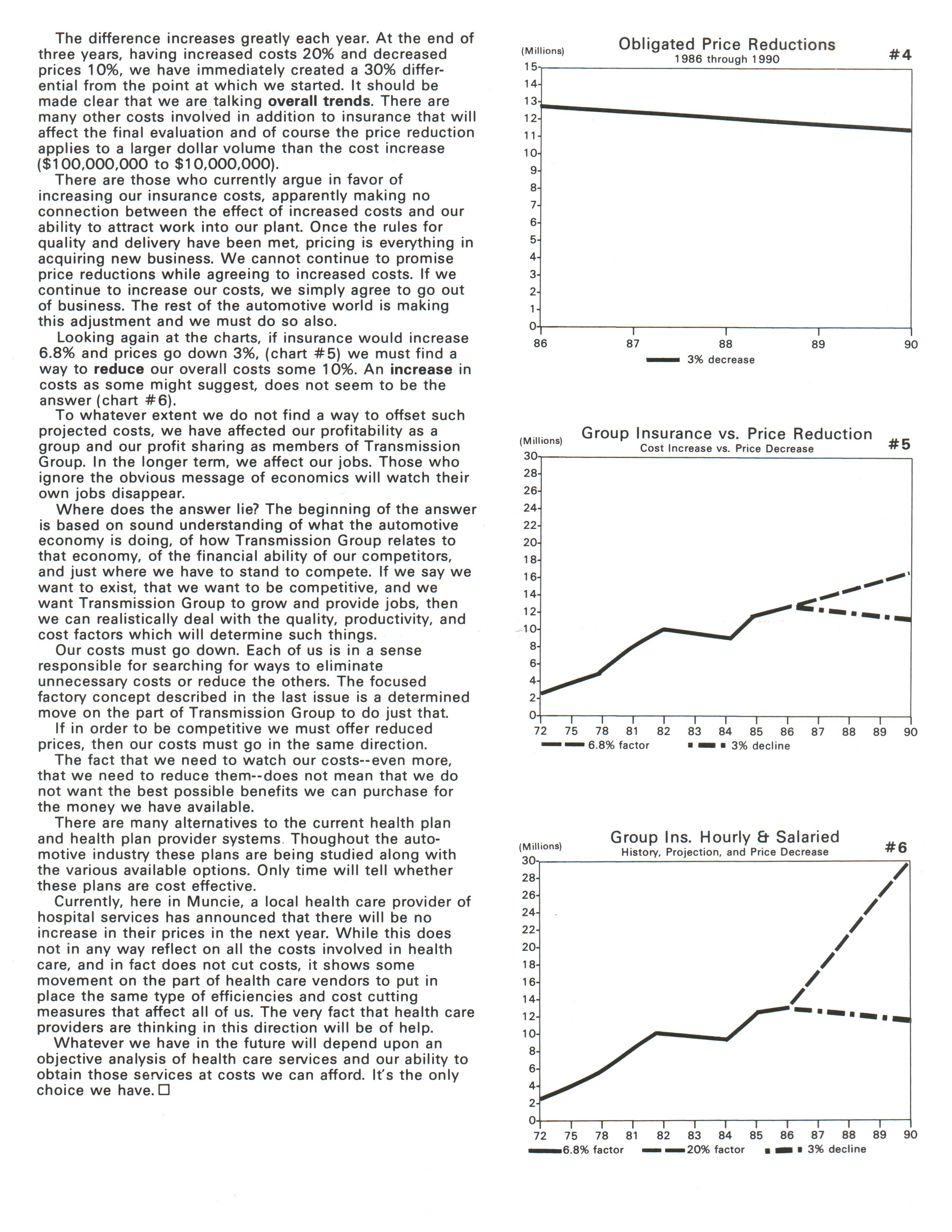 |
|
Article written by Glen Eckelman and taken from the July 1985 edition of The News (p. 1, 2). It discusses the rising cost of healthcare and the impact this will have on the factory. BorgWarner Newsletter Collection (1944-2004), Muncie Public Library, Muncie, IN. |
|
As a result of the rising cost of healthcare, the factory began to focus more on preventative health such as encouraging good nutrition and exercise, offering seminars on how to quit smoking for example, instituting a wellness program, and ultimately building a healthcare center specifically for employees in order to lower insurance costs.
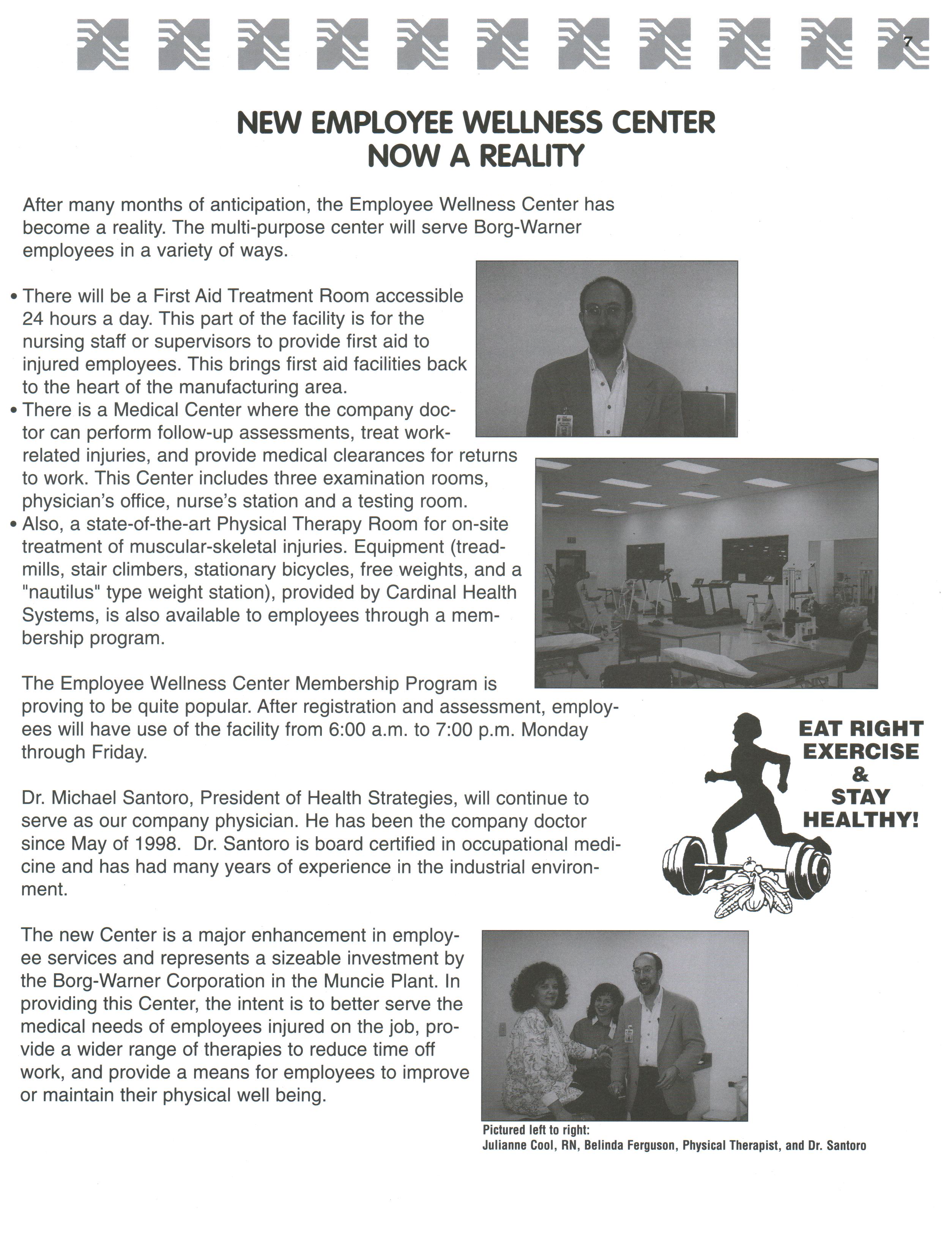 Article taken from the April 1999 edition of Shifting Times (p. 7). It informs employees about the new Wellness Center that opened in 1999. BorgWarner and Cardinal Health System partnered together to offer a wellness center within the Kilgore plant to employees. Employees could consult a doctor about their work-related injuries. Furthermore, the site had an exercise room available to the workers in the hope that they would try to get in in better shape in order to reduce injuries. The center mainly saw repetitive trauma-related injuries, which is quite common in a factory environment. BorgWarner Newsletter Collection (1944-2004), Muncie Public Library, Muncie, IN. |
For BorgWarner, healthcare was a dividing issue between management at the plant as well as the union. It led to strikes at the plant including the strike of 1989, which last for 52 days. Borg Warner was a community of people, and the workers looked out for their own whether they were still employed at the factory or had retired at that point.
BorgWarner Community
Celebrating Service, Building Camaraderie
Even though BorgWarner was a place of work, the company stressed the importance of community within the workplace by hosting activities that would in essence build camaraderie among the workers and celebrate their service to the company. BorgWarner would host receptions for those who had given a certain number of years of service or more. Those who were eligible would receive a pin designating how many years he/she worked for the company. Employees who had worked there forty years or more were not only given a pin but also a commemorative watch (The News, November 1990).
|
John Fenimore discusses his retirement, banquets for those who have given a certain number of years of service, and the pins given to employees for every five years of service. BorgWarner Oral History Collection (2019), Muncie Public Library, Muncie, IN. |
|
|
|
| 30 year commemorative pin given to John Fenimore in 1991 by BorgWarner for 30 years of service to the company. | |
BorgWarner also celebrated TeamWork Day, which began in 1999 and became an annual event due to its huge success. During this day, all employees would meet during each shift in order to learn more about working together as a team. Furthermore, this was an opportunity to display projects and activities that contribute to the success of the company and improve the quality of the product. Last, employees were treated to a free lunch and a T-shirt (Shifting Times, July 2000).
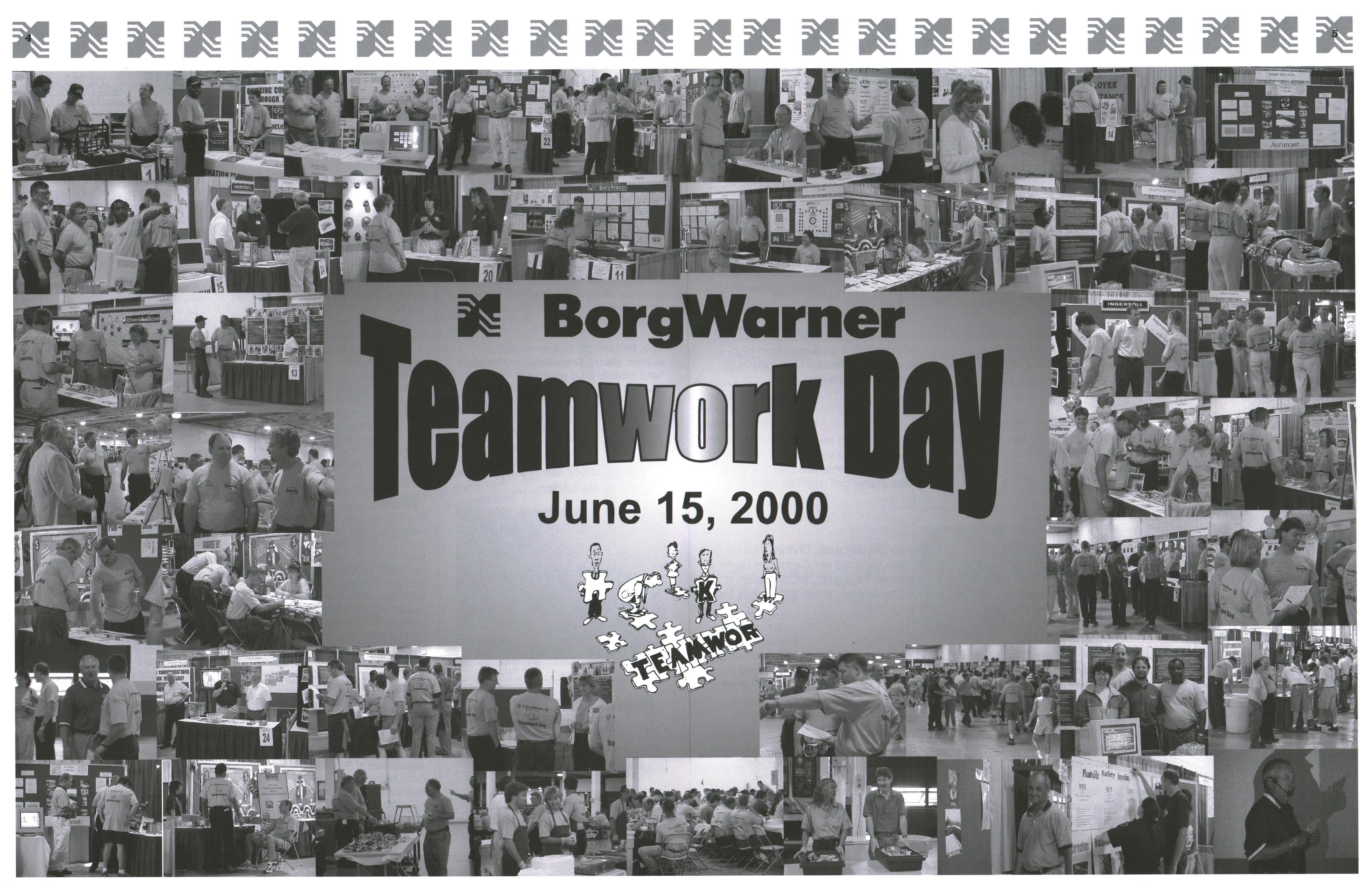 |
|
Are you in one of the photos? Do you recall any other activities hosted by the company that made you feel as if you were part of a work community? (Shifting Times, 2000, p. 4, 5) BorgWarner Newsletter Collection (1944-2004), Muncie Public Library, Muncie, IN. |
We really grew together…. I mean, I went to their house for dinners, for meals…. It was really a good bonding experience.”
|
The labor union UAW-CIO Local 287 associated with BorgWarner also created a sense of community among BorgWarner workers, mostly through events but also by initiating strikes and negotiating contracts. Neil King, in this next video, gives us a sense of the atmosphere during the strikes from his tenure as a BorgWarner employee (1986-2007).
|
Neil King discusses union activities and the solidarity with his work community that he felt during the labor strikes instituted by UAW-CIO Local 287. BorgWarner Oral History Collection (2019), Muncie Public Library, Muncie, IN. |
Sports Leagues
The plant as well as the union, UAW-CIO Local 287, sponsored many leisurely activities and sports leagues for employees to get involved in and connect to their co-workers. One such example is bowling, which figured prominently in Ron Hughes’ experience with BorgWarner. John Fenimore also recalled that this mother had participated in a bowling league during her time at BorgWarner when it was still called Warner Gear.
|
Ron Hughes talks about the different sports leagues hosted by BorgWarner as well as the union UAW-CIO Local 287. Afterwards, Neil King discusses playing basketball with co-workers after his work shift. Were any of you involved in sports? If not, what sorts of activities did you participate in with co-workers? BorgWarner Oral History Collection (2019), Muncie Public Library, Muncie, IN. |
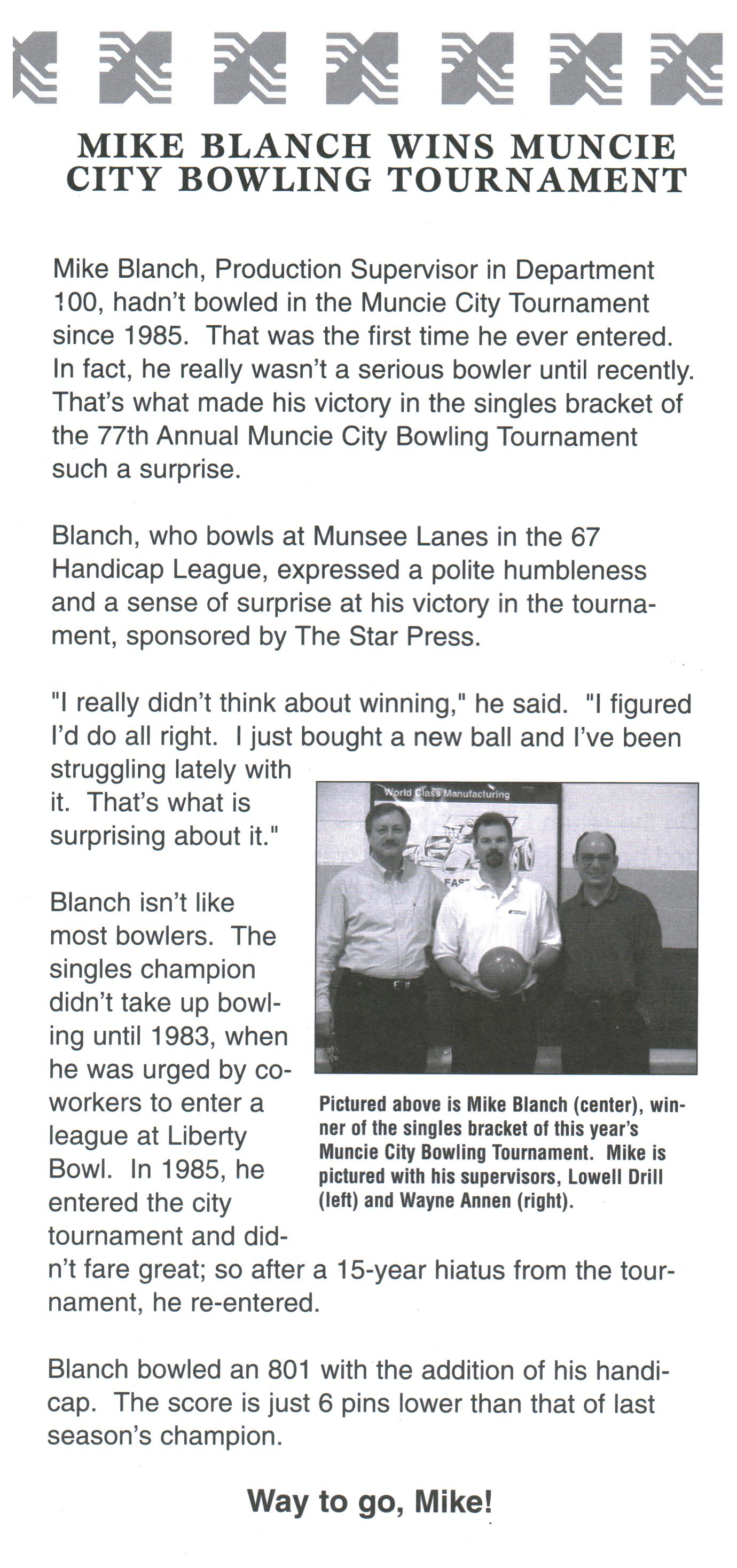 |
|
Bowling and golf were popular sports that employees participated in within the BorgWarner company. Sports were very much a way for people to socialize and gain a sense of community with their peers, similar to families who participate in high school sports whether as players or spectators. (Shifting Times, March 2000, p. 4) BorgWarner Newsletter Collection (1944-2004), Muncie Public Library, Muncie, IN. |
Family
The company also encouraged family life by hosting family picnics and get-togethers and opening the factory for tours for family members. Krista Wagner, whose father worked at Warner Gear until 1971, remembers going on a tour in the 1970s and being fascinated by one of the robotic arms used in the manufacturing process.
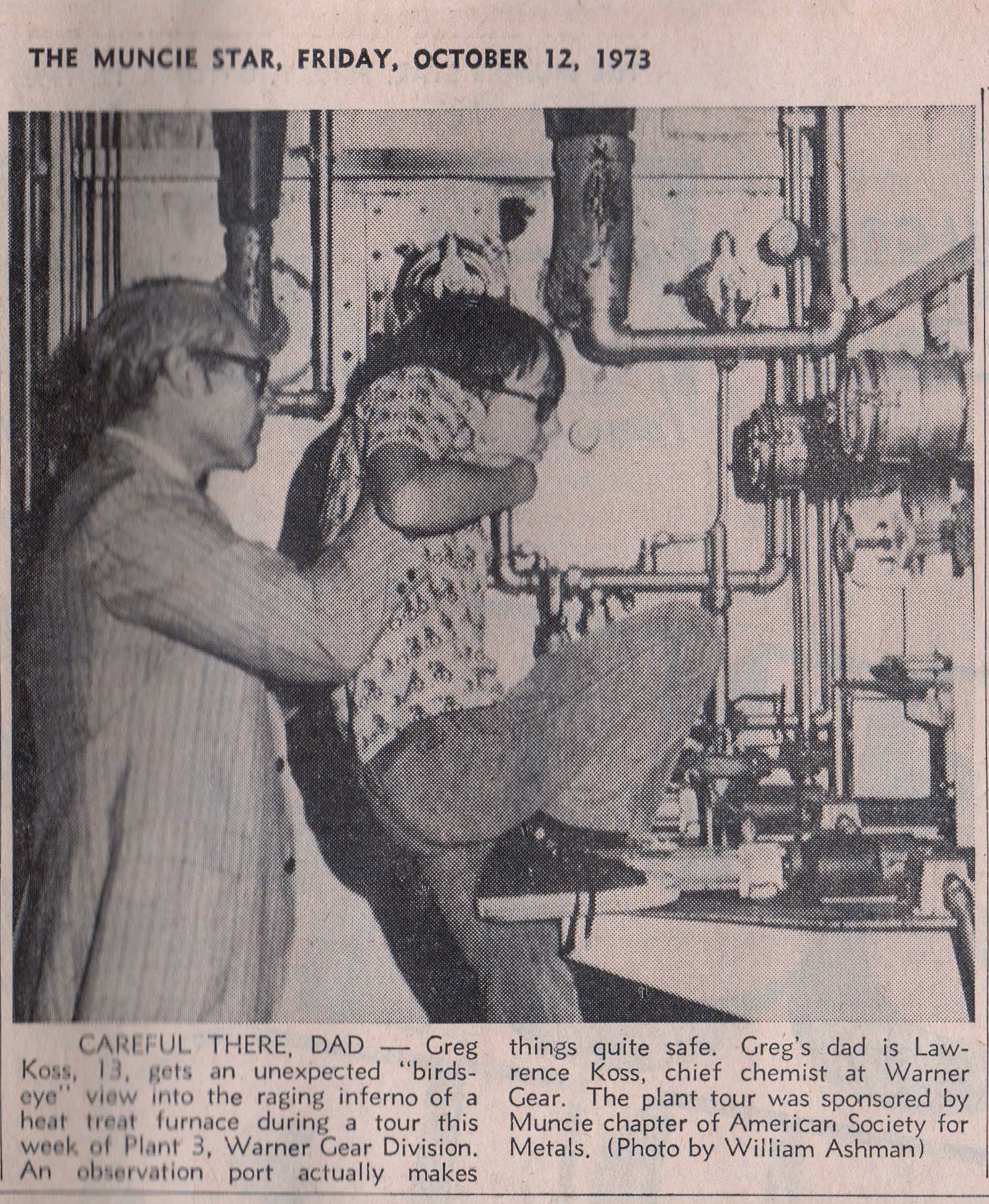 |
|
Family members of BorgWarner employees were sometimes invited to tour the plant during company open house days. It was an opportunity for family members to see firsthand the work environment and learn about what Mom and Dad did for a living to provide for the family. Muncie Star. (1973, October 12). pp. 16C. |
Another interviewee, John Fenimore, talked about the Christmas parties and the roller skating events his family enjoyed attending. Many of the employees also spoke of picnics at Springwater Park once located at 5000 E. Centennial St., 100 N. and Christmas parties both hosted by the local union, UAW-CIO: Local 287.
1.
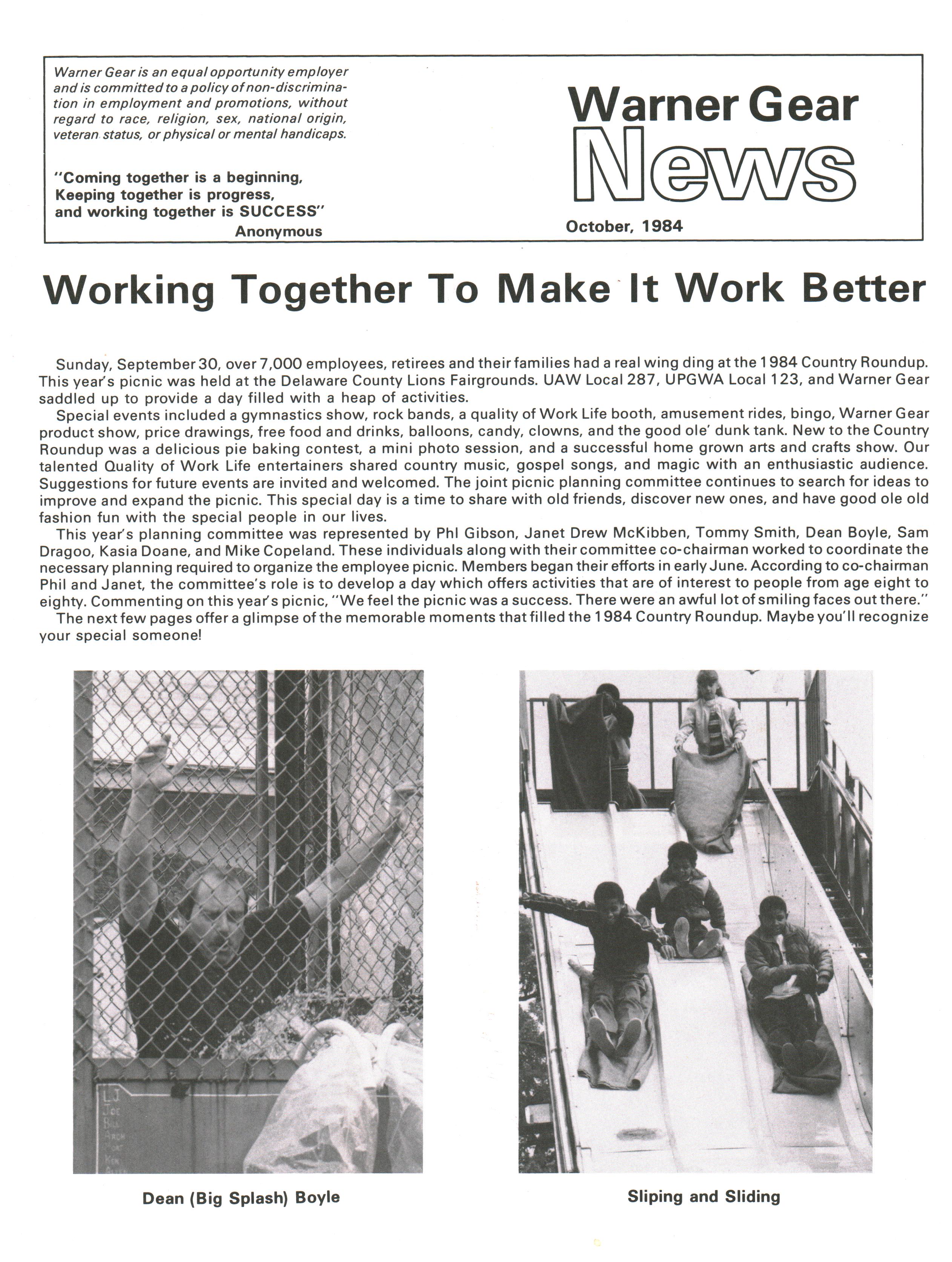 |
1.
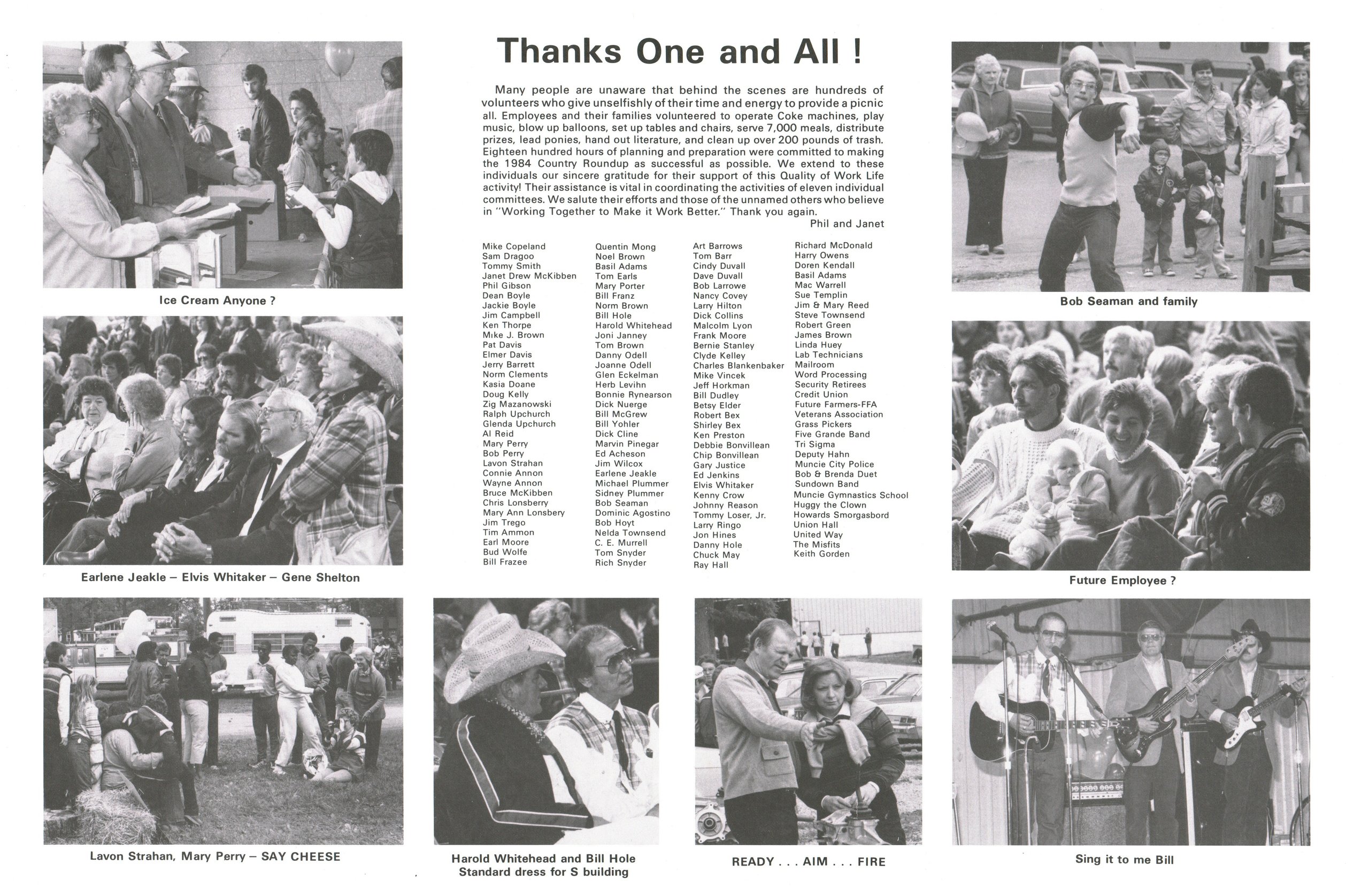 |
|
1.
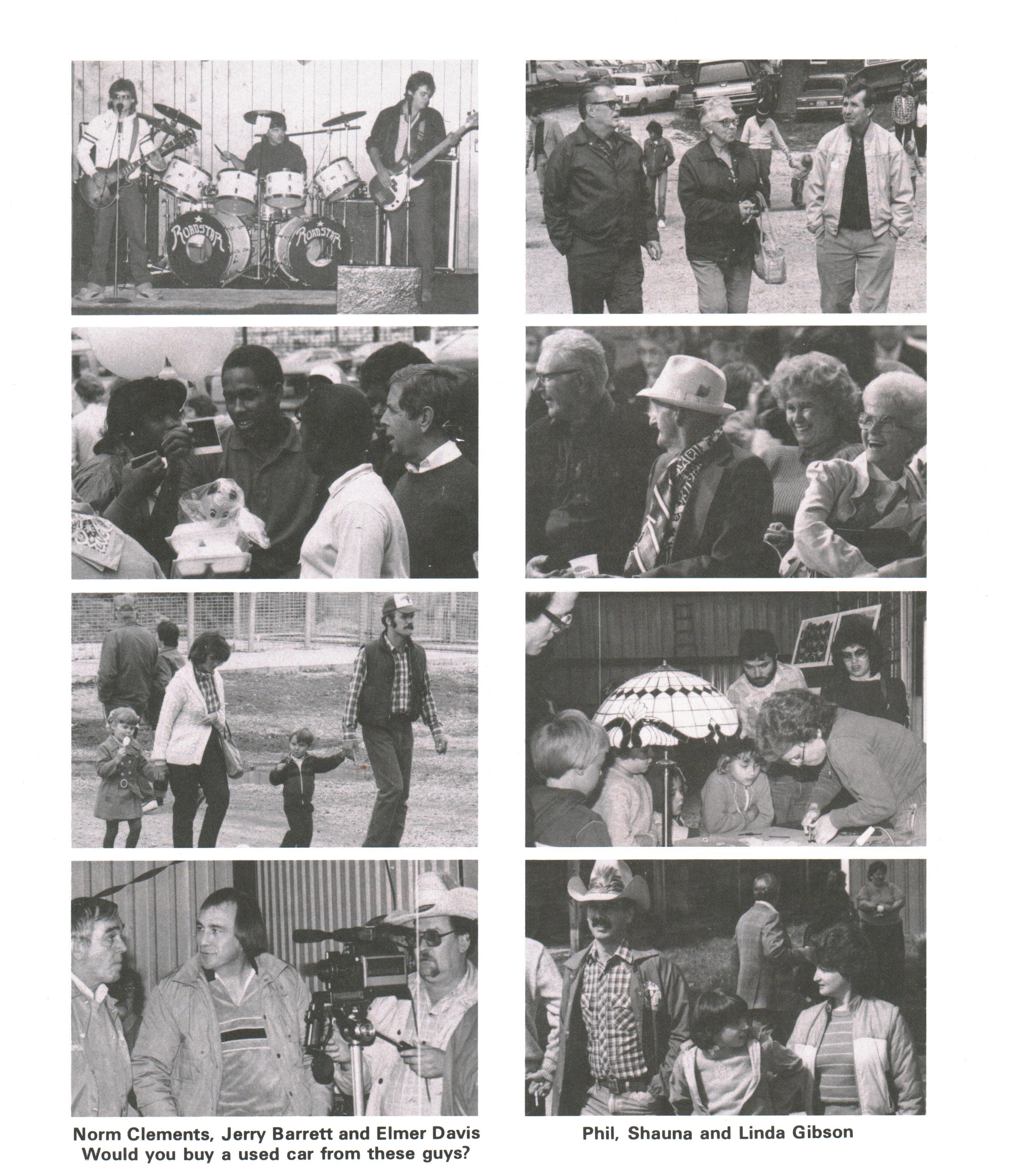 |
2.
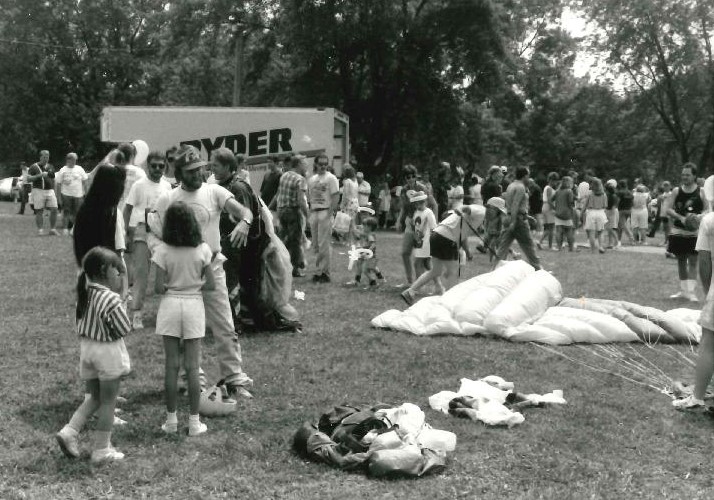 |
|
2.
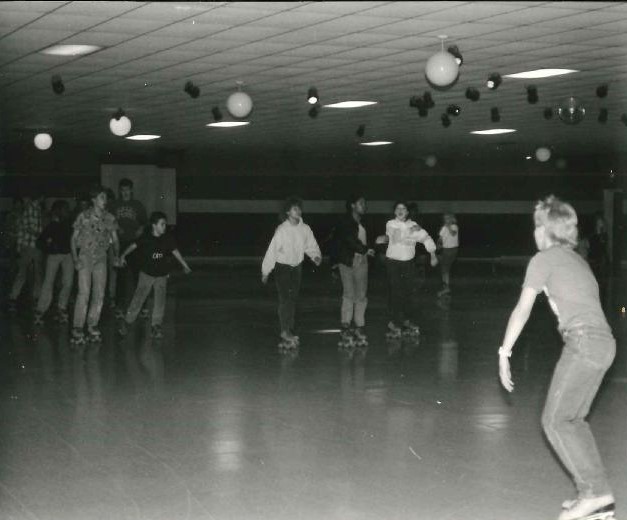 |
2.
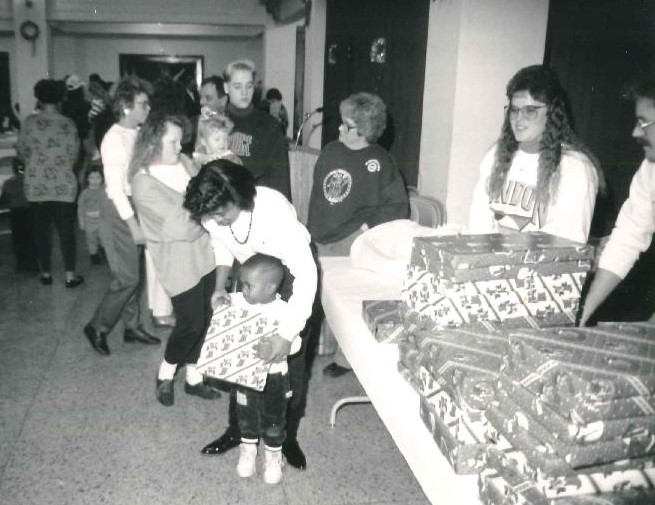 |
|
|
Various family activities hosted by Warner Gear/BorgWarner and UAW-CIO, Local 287. Did you have any favorite activities? 1. BorgWarner Newsletter Collection, Muncie Public Library 2. MSS.165/P.279, UAW-CIO, Local 287 records and photographs, Ball State University Archives and Special Collections Photographs courtesy of and used with the permission of Ball State University Archives and Special Collections. |
||
Investigate the Archives: Want to see more photographs of Local 287? Check out Ball State University's Archives and Special Collections and ask for P.279, UAW-CIO, Local 287 photographs. |
|
John Fenimore, Marlene Mitchell, and Frank Scott discuss the family activities that they participated in while employees of Warner Gear/BorgWarner. The company and the union both hosted all sorts of activities for employees and their families. BorgWarner Oral History Collection (2019), Muncie Public Library, Muncie, IN. |
Closing of BorgWarner
|
Neil King talks about his reaction when it was announced that BorgWarner would close. BorgWarner in Muncie finally closed its doors permanently in 2009, and the factory just sat there empty, waiting for another organization to use the space it had occupied. However, nothing came to fruition, and demolition on the factory began in 2017. BorgWarner Oral History Collection (2019), Muncie Public Library, Muncie, IN. |
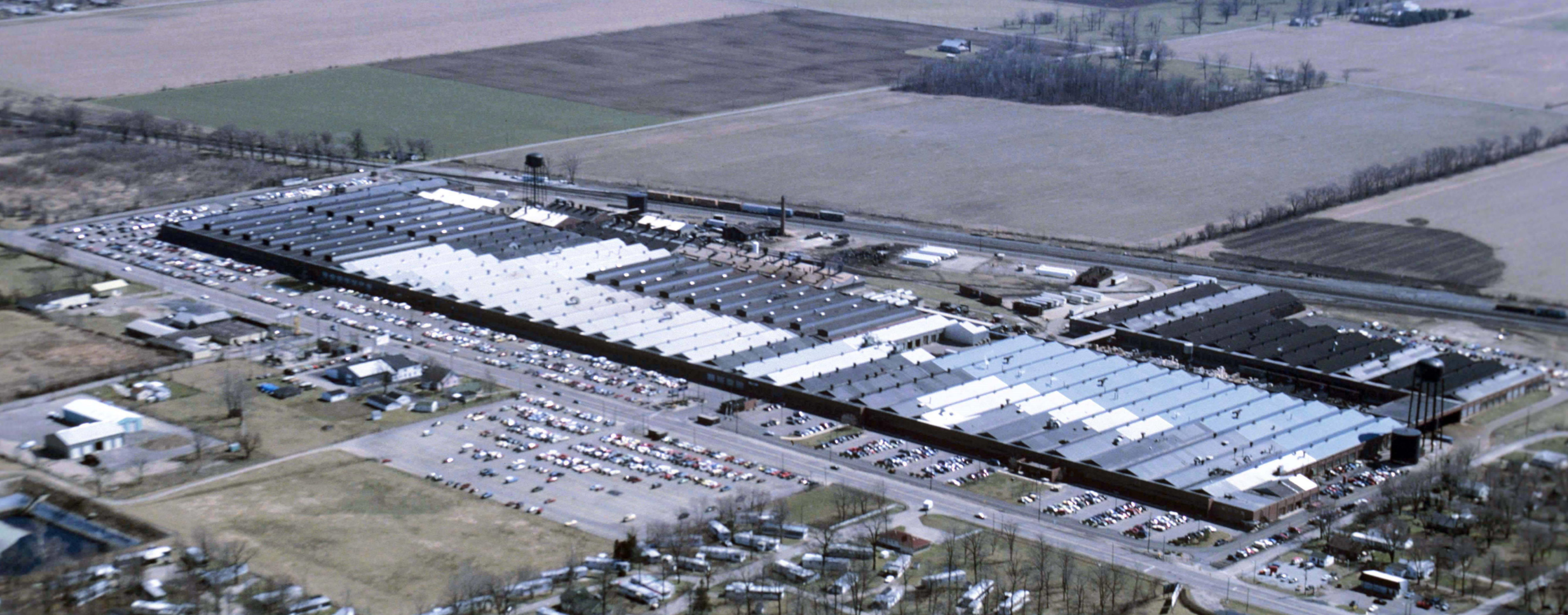 |
|
An aerial view of the BorgWarner plant on Kilgore Ave. circa 1985-2005 Photograph courtesy of and used with the permission of Ball State University Archives and Special Collections |
BorgWarner in Muncie finally closed its doors permanently in 2009, and the factory just sat there empty, waiting for another organization to use the space it had occupied. However, nothing came to fruition, and demolition on the factory began in 2017.
|
|
|
|
|
|
|
|
|
Photographs of the demolition taken in September 2017. Photographs taken and used with the permission of Krista Wagner, whose father once worked at Warner Gear. |
||
Personal Impact
Muncie has moved on in the ten years since BorgWarner closed its doors, but the impact of its loss still resonates both with those who worked there and within the community itself. On a personal level, the employees miss the friends they made and the inner community that BorgWarner and the union encouraged within the factory through its sports leagues, employee picnics, and just day to day social interaction.
Job security was also something the factory provided despite the number of layoffs many experienced within the first few years of work while employees built up seniority. Those who worked at the plant had good pay, good benefits, and could take vacations when they wanted time off, mainly thanks to the union. Local 287 ensured that the company honored its commitments and fought if it did not. In fact, feelings still run high with regard to BorgWarner ten years later. After the loss of other big industries like Ball Brothers Corporation and General Motors in Muncie, it was one of the last big employers within the Muncie community, and it is sorely missed by those who worked there.
However, not all personal impacts from the closing of the plant were negative. Frank Scott discusses how BorgWarner opened doors for him thanks to its education program for those who lost their jobs. Listen how he and others talk about how the closing of the factory impacted their lives.
|
Frank Scott, Neil King, and Ron Hughes discuss how the closing of the plant affected their lives. All three men lost their jobs when the plant announced that it was closing its doors permanently and had to seek employment elsewhere. BorgWarner Oral History Collection (2019), Muncie Public Library, Muncie, IN |
“No one’s ever going to forget BorgWarner in Muncie.”
|
Ron echoes the loss felt by many of those who worked at Borg Warner. So much of people’s lives were tied up within the factory that even to this day, ten years later, they still feel nostalgic, missing the good ole' days. Others have stated that they were glad to get out of the factory despite feeling the absence of friends made during that time.
In his interview, Frank Scott said as he pointed to his heart, “There’s something still here from there.” How do you feel about the factory ten years after it closed? Can you relate? What do you miss?
|
|
|
The BorgWarner lot after demolition was completed. Photograph taken and used with the permission of Krista Wagner, whose father once worked at Warner Gear. |
Community Impact
Philanthropy within the community has always been an important part of company culture up until the factory closed. BorgWarner employees gave blood, participated in Toys for Tots, gave money to the United Way Fund, raised money for the Youth Opportunity Center just to name a few examples of community involvement. Many of the workers took pride in this aspect of the company. Community involvement was a defining feature of the company, and Muncie felt the impact of its loss within the community when the factory finally closed its doors in 2009.
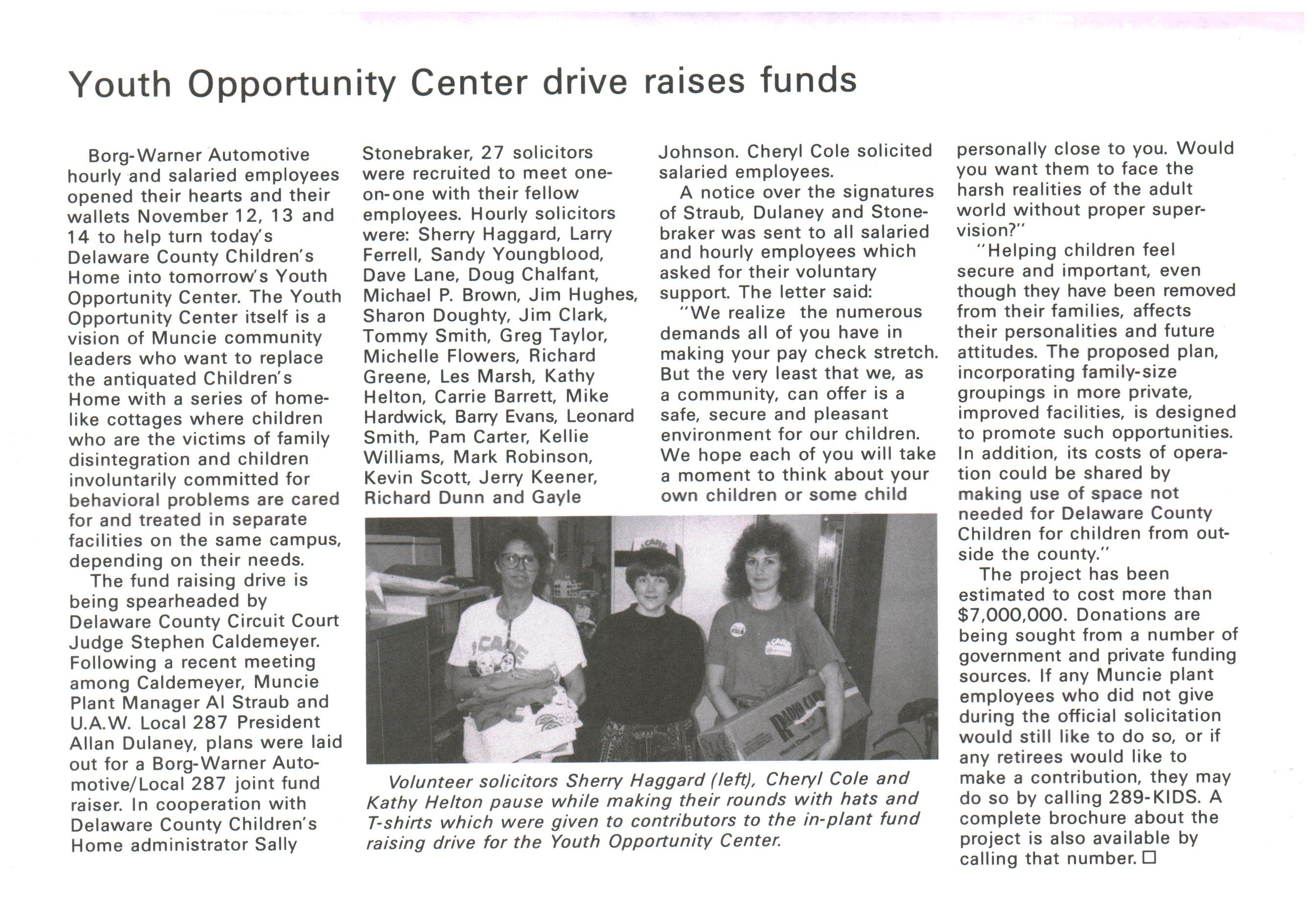 |
|
This article taken from the November 1990 edition of The News (p. 4) discusses the fundraiser at Warner Gear to raise funds for the Youth Opportunity Center. Employees raised $87,115 for the center (The News, 1990 December, p. 3). BorgWarner was very active and involved within the Muncie community and worked with the community in order to help better it for all who lived there. What sorts of philanthropy activities do you remember from your time at the plant? BorgWarner Newsletter Collection (1944-2004), Muncie Public Library, Muncie, IN. |
“I wasn’t ashamed to tell anyone I worked there.”– John Fenimore |
Today, Muncie is no longer the booming, industrial community that it was at its height in the 1960s, and the population demographic shows this today. According to STATS Indiana (n.d.), our population in Muncie hit its peak in 1980 at 77,216 people, and in 2010 for the last census, we had 70,085, which is a 9% drop in population. The school system has shrunk, and many of the former BorgWarner employees have commented that many of their friends and former co-workers have moved in order to find jobs, or they have to commute to work. Muncie once had three major high schools, and we are now down to just one central high school, which consolidated in 2015. We also see this in the loss of recreational pursuits such as golf and bowling. Recently, it was announced in the Muncie Star Press, our community’s newspaper, that the mall is facing some financial difficulties and may be forced to close (Slabaugh, 2019).
Another problem that the community (and Indiana in general) has is the growing opioid epidemic. More than 750 overdosed on opioids in Delaware County in 2017 with 65 of those overdoses being fatal (Walker, 2017). Marlene Mitchell commented that she believed that the drug problems we have now in the Muncie community stem from the loss of jobs. The young people here have no opportunities or training in order to make a living in Muncie anymore. She further points to the effect that the loss of jobs has had on family life within the community. In the video below, she and others discuss this as well as the other community impacts that the loss of BorgWarner and the other major industrial factories has caused within Muncie.
|
Marlene Mitchell, Ron Hughes, and Frank Scott talk about the effects that the closing of BorgWarner has had on the community. Some examples include loss of population, increased drug use, reduced economic growth, and a decrease in recreation. BorgWarner Oral History Collection (2019), Muncie Public Library, Muncie, IN. |
What sort of issues do you see in our community today? Can you trace this to the loss of BorgWarner and other industries in Muncie, or do you think that other outside factors may have influenced the community we live in now?
Muncie's Future
The BorgWarner plant was one of the last established companies to leave Muncie, and the community and its people still feel the impact nine years later. In fact, in many ways, we are still recovering from the loss and trying to attract local businesses to invest in our town. The community is very much trying to find its place, transitioning itself into a post-industrial, modern community capable of surviving the hard times that it has seen in the past few decades.
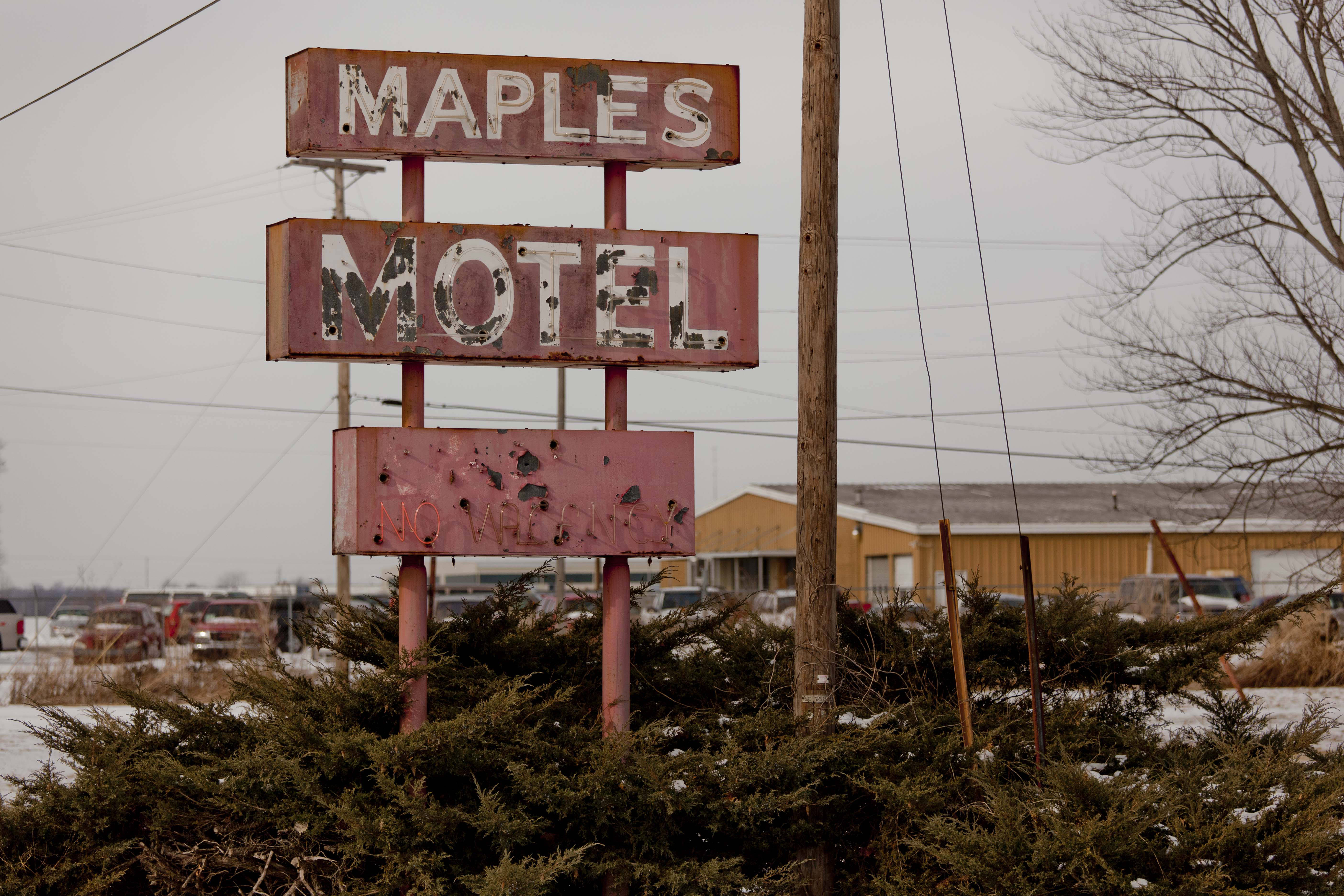 Photograph 1: Maple's Motel Sign |
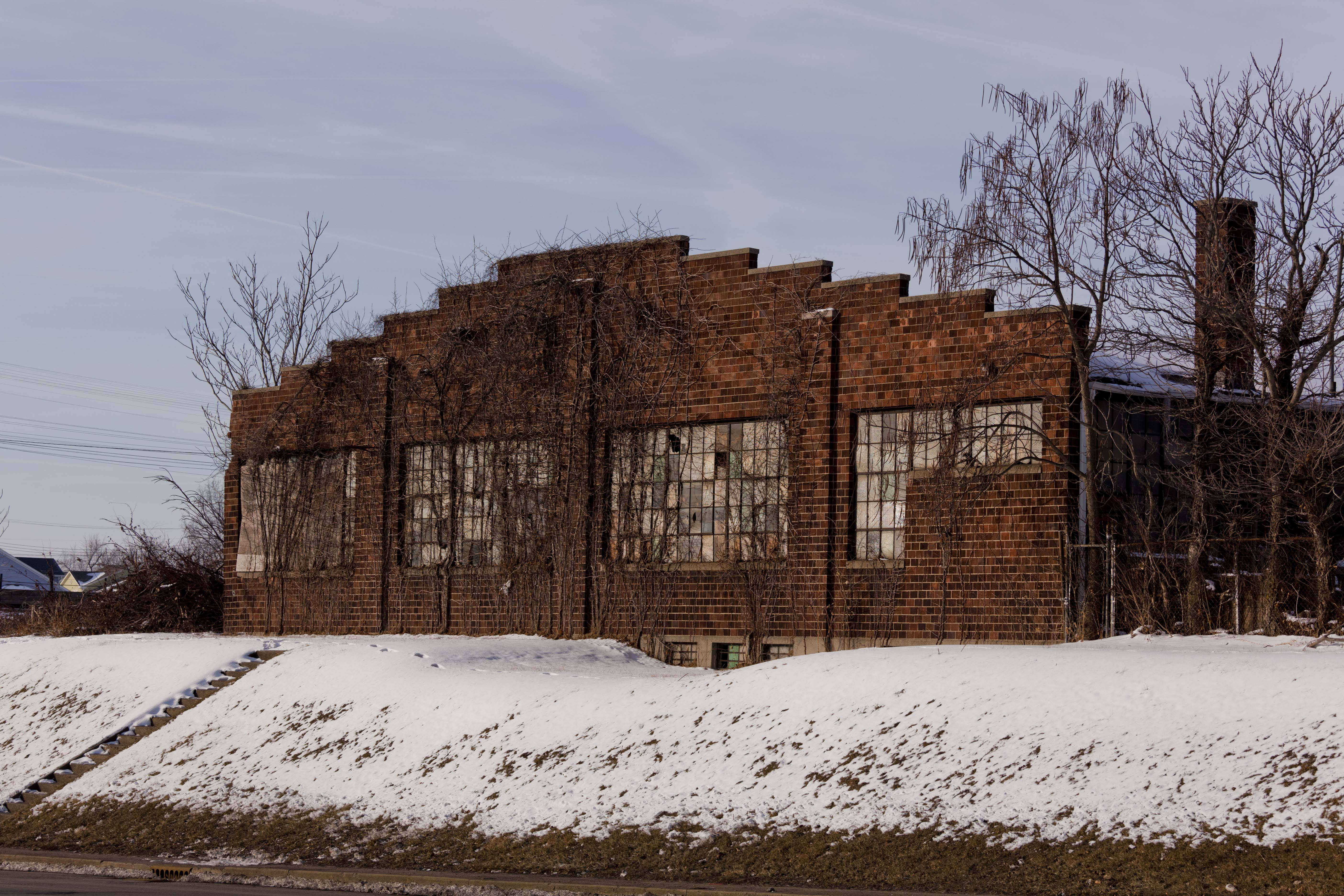 Photograph 2: Unidentified building |
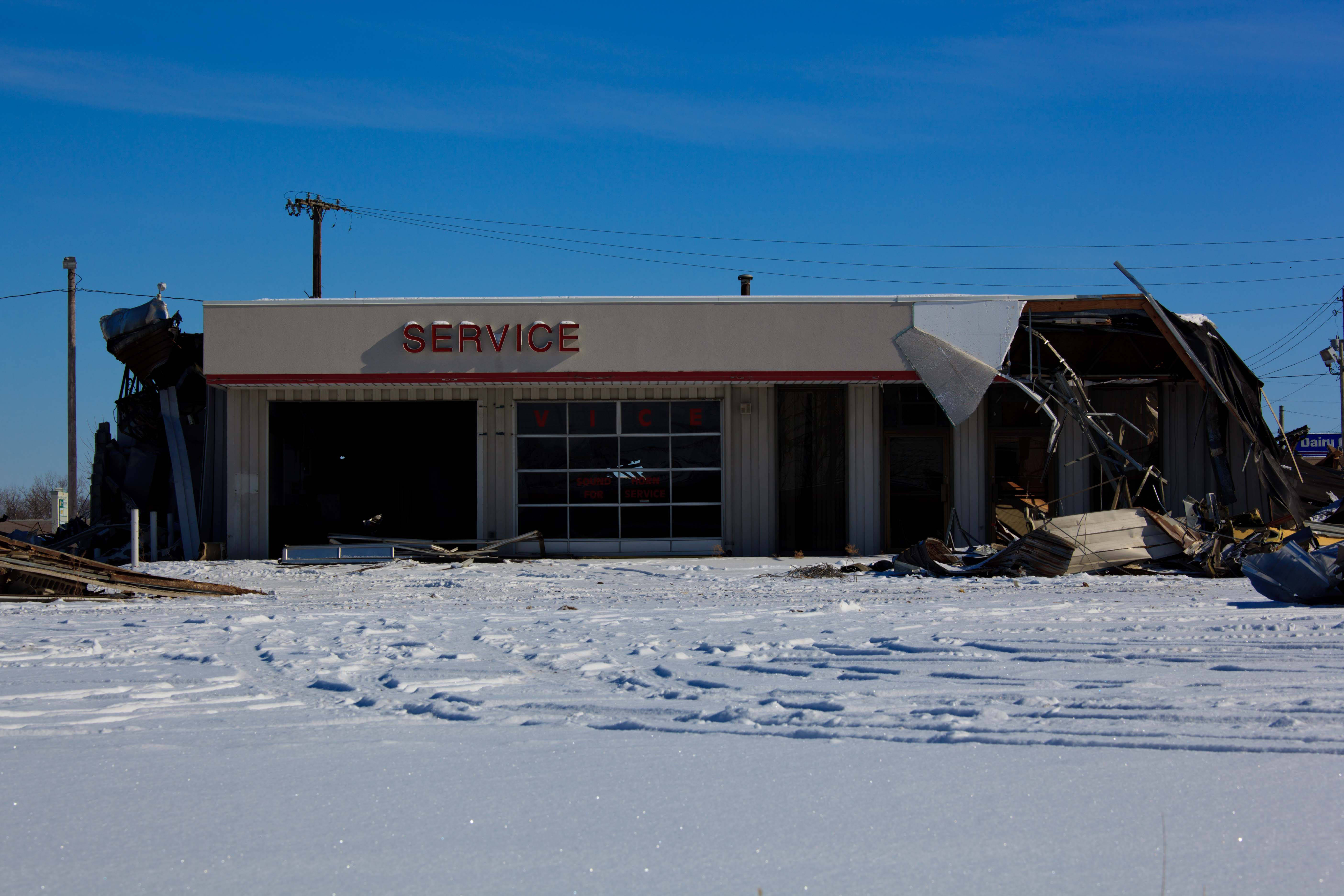 Photograph 3: Dilapidated Toyota service shop |
|
These photographs were taken in various locations around Muncie, Indiana by David Patashinsky in 2010-2011. They were commissioned by the Center for Middletown Studies at Ball State University as part of the organization’s Documenting Deindustrialization Initiative. Photographs courtesy of and used with the permission of Ball State University Archives and Special Collections |
||
With the closing and demolition of BorgWarner in particular, the community felt that the site would stay empty for the foreseeable future, but recently, Muncie received some exciting news regarding the old site on Kilgore Avenue.
Heritage Environmental and Zinc Nacional
In January 2019, Waelz Sustainable Products, a partnership between Heritage Environmental (Indianapolis) and Zinc Nacional (Monterrey, Mexico), made an announcement at the Horizon Convention Center in Muncie regarding the future of the BorgWarner site. The company will construct a Waelz kiln facility, which is projected to be operational in late 2020. The Waelz kiln process converts the by-product from the electric arc furnaces in steel mills into zinc that can be used for many different types of products like galvanizing steel, ointments, tire and rubber, lubricants, and much more (Muncie-Delaware County, Indiana Economic Development Alliance, 2019). It is hoped that the coming of this new company will help revitalize manufacturing within Muncie and create more jobs. However, recently, community members have expressed concern over the effect that the new plant will have on air quality in terms of lead pollution (Slabaugh, 2019).
|
WISH-TV (2019, January 9) announced that Heritage Environmental and Zinc Nacional would redevelop the BorgWarner site into a Waelz kiln facility and bring more jobs into Muncie, IN, jobs that would move the community into the future. WISH TV. (2019, January 9). Redeveloping BorgWarner site in Muncie, Indiana [Video file]. Retrieved from https://www.youtube.com/watch?v=wPGViJ0vHVI |
What do you think? Where is Muncie going?
Whether you heard the news about the new development on the BorgWarner site now or in January when it was originally announced, what do you think about it? Is this a good thing for Muncie or will it end up like the rest of the businesses that have come and gone?
Overall, where do you think Muncie is going? Are we headed in the right direction? These are questions that are still relatively unanswered. We all have our different ideas on what the future of Muncie will entail. Here are some thoughts about what Muncie needs to focus on in order to have a successful future as a community.
“We got to have our factories. We’ve got to have our manufacturing. Our politicians don’t think we do need manufacturing, but we have to have manufacturing. We need those jobs back cuz we can’t live on ten dollars an hour. It’s crazy.” – Ron Hughes |
|
Neil King, Marlene Mitchell, and Frank Scott talk about what they think Muncie needs in order to thrive and grow as a community. BorgWarner Oral History Collection (2019), Muncie Public Library, Muncie, IN. |
What do you think? Do you agree or disagree?
Resources
Automobility in Muncie: The Genesis of Warner Gear (n.d.); Carnegie Library Vertical File, Muncie Public Library, Muncie, IN.
Ball State University campus photographs collection. (n.d.). Ball State University Digital Media Repository. Retrieved from https://dmr.bsu.edu/digital/collection/photo
Ball State University Libraries. (2016). Changing Gears: End of an Era, 2010 [Video file]. Retrieved from https://www.youtube.com/watch?v=IjNn7Znl-s4
BorgWarner Newsletter Collection (1944-2004), Muncie Public Library, Muncie, IN.
BorgWarner Oral History Collection (2019), Muncie Public Library, Muncie, IN.
Changing Gears documentary film collection. (2010-2014). Ball State University Digital Media Repository. Retrieved from https://dmr.bsu.edu/digital/collection/ChngGrsDoc
Conatser, R. (1985-2005). Muncie, IN Warner Gear aerial view. Ball State University Digital Media Repository. Retrieved from https://dmr.bsu.edu/digital/collection/CntsrArlPht/id/3175/rec/4
Dignitaries at Warner Gear Plant. (n.d.). Ball State University Digital Media Repository. Retrieved from https://dmr.bsu.edu/digital/collection/INBrdgCmp/id/988/rec/90
Gear-O-Gram magazine collection. (1944-1972). Ball State University Digital Media Repository. Retrieved from https://dmr.bsu.edu/digital/collection/GoGramNews
Greene, Richard A. (n.d.). Copy of Old Picture of Warner Gear Employees [Photograph]. Ball State University Digital Media Repository. Retrieved from https://dmr.bsu.edu/digital/collection/sg/id/1449/rec/148
Manganello, T. (May 1998). Make it in Muncie. Shifting Times. BorgWarner Newsletter Collection, Muncie Public Library. (p. 1)
McNeese, B. (2009). The red beads: Understanding variation. SPC for Excel. Retrieved from https://www.spcforexcel.com/knowledge/variation/red-bead-experiment
M.L. Photo. (1900s). Warner Gear Company, Muncie, IN [Photograph]. Ball State University Digital Media Repository. Retrieved from https://dmr.bsu.edu/digital/collection/MunHisPhoto/id/1146/rec/163
Muncie-Delaware County, Indiana Economic Development Alliance. (2019). Heritage Environmental & Mexico-based Zinc Nacional to Establish Waelz Kiln Facility in Muncie, Indiana. Retrieved from http://muncie.com/About-Us/News-Media/News/Heritage-Environmental-Mexico-based-Zinc-Nacional.aspx?fbclid=IwAR2l9uAbMCej3f3pKrk0_0UyvwZCDz2EtKxGeyDA2LqAOHyDevXH9gOa-hY
Muncie Star. (1973, October 12). pp. 16C.
Quincunx board. (2019). In BusinessDictionary. Retrieved from http://www.businessdictionary.com/definition/quincunx-board.html
Patashinsky, D. (2010-2011). David Patashinsky Muncie, IN Photographs, Archives and Special Collections, Ball State University Libraries, Muncie, IN. Retrieved from https://dmr.bsu.edu/digital/collection/Patashinsky
Sellers, Otto. (1914). Warner Gear Company Transmission [Photograph]. Ball State University Digital Media Repository. Retrieved from https://dmr.bsu.edu/digital/collection/sellers/id/97/rec/56
Slabaugh, S. (2019). Future of Muncie mall uncertain as owner plans to return it to bank. Muncie Star Press. Retrieved from https://www.thestarpress.com/story/news/local/2019/05/30/ceo-analysts-muncie-mall-didnt-make-grade/1220595001/
Slabaugh, S. (2019). Steel-dust recycling facility raises concerns. Muncie Star Press. Retrieved from https://www.thestarpress.com/story/news/local/2019/06/22/steel-dust-recycling-facility-concerns-raised/1523852001/
STATSINDIANA. (n.d.). Indiana City/Town Census Counts, 1900-2010. Retrieved from https://www.stats.indiana.edu/population/PopTotals/historic_counts_cities.asp
UAW-CIO, Local 287 records and photographs, Archives and Special Collections, Ball State University Libraries.
Wagner, K. (2017). BorgWarner demolition digital collection.
Walker, D. (2017). The year in drugs: Community slammed by opioids tidal wave. Retrieved from https://www.thestarpress.com/story/news/crime/2017/12/28/year-drugs-community-slammed-opioids-tidal-wave/980801001/
Warner Gear. (n.d.). Carnegie Library Vertical Files, Muncie Public Library, Muncie, IN.
Wells, J.M. (1960, October 5). Senator John F. Kennedy in front of Warner Gear on U.S. 32 [Photograph]. Ball State University Digital Media Repository. Retrieved from https://dmr.bsu.edu/digital/collection/FrlEvrtW/id/653/rec/130
WISH TV. (2019, January 9). Redeveloping BorgWarner site in Muncie, Indiana [Video file]. Retrieved from https://www.youtube.com/watch?v=wPGViJ0vHVI
About the Exhibit
This exhibit was inspired by that dialogue from the first Warner Gear (BorgWarner) Reunion. We here at Muncie Public Library wanted to continue the conversation about what’s happening within the community and ways that we can move forward from the deindustrialization that we see happening around us. Also, this is way that we can reminisce and look to our past in order to move towards and embrace our future as a community. Please feel free to explore the exhibit and think about some of the topics presented here. We would love to hear your story and would like to continue capturing oral histories about the plant for future generations to enjoy and learn. If you are interested in recording your story, please contact Alexis Robertson at 765-747-8209.
Contributors:
Project Coordinator: Alexis Robertson
BorgWarner Oral History Project
Narrators: John Fenimore (1959-1991), Ron Hughes (1986-close), Neil King (1986-close), Marlene Mitchell (1973-1991), and Frank Scott (1983-close)
Interviewer: Alexis Robertson
Videographer: Noelle Gudger
Video Editing: Alexis Robertson and Noelle Gudger
Recording Locations: Carnegie Library and Idea Studio @ Maring-Hunt Library
BorgWarner Digital Exhibit
Exhibit Research and Writing: Alexis Robertson
Exhibit Design: Alexis Robertson
Webmaster: Noelle Gudger
We would like to give a special thank you to Ball State University Archives and Special Collections for sharing content for this exhibit. Also, thank you to Dr. Jim Connolly from Ball State University. Last, but not least, we would like give a huge shoutout to Carnegie Library's staff for the research help and the use of the library's meeting room space for the interviews!
